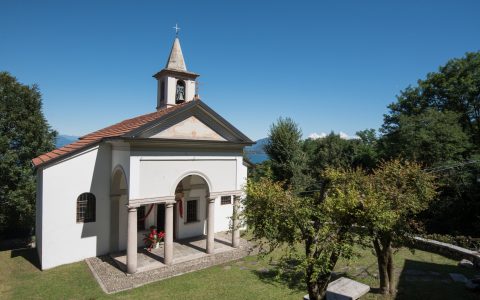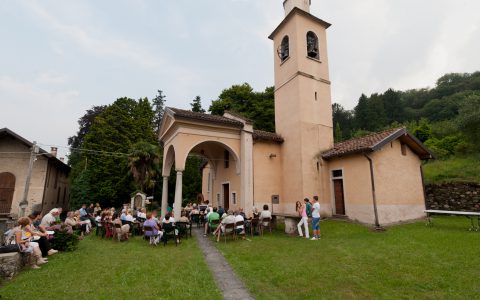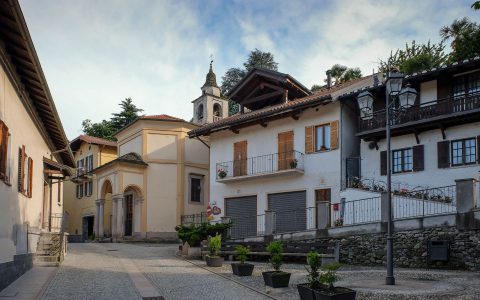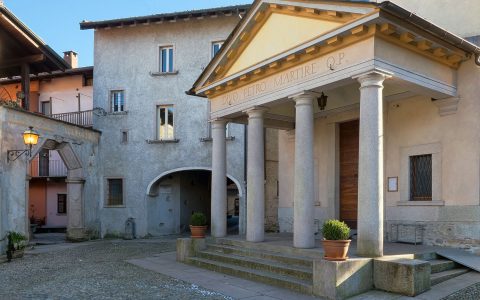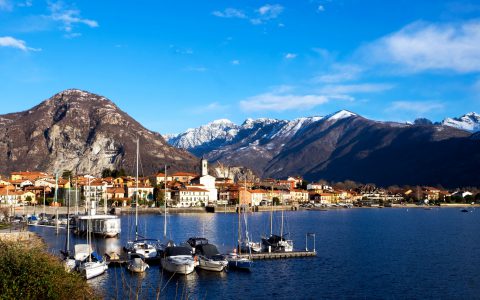Hamlets in Baveno
LOITA
Of easy reach, Loita offers breathtaking views of the Borromeo Gulf, the coast of Baveno, the peninsula of Pallanza and everywhere around the mountains. A wonderful small white church consecrated to St. Fermo dominates the landscape and its terrace position make of it an extraordinary view point from where you can enjoy one of the most beautiful views of Lake Maggiore. Harmoniously inserted within the context of the building, renovated on many occasions, there is inside a chapel consecrated to St. Barbara, patron saint of miners, built in 1905 by the powder factory ‘Salvi & Locatelli’ after an explosion that caused the death of a worker.
RONCARO
The panoramic route comes to an end in Roncaro with the Oratory of 1700 devoted to ‘Our Lady of Sorrows’; in 1821, the porch was added re-utilising the granite columns of the old church of Stresa and the bell tower dates back to 1830. Opposite, we can find in an ancient courtyard, engraved on a bench of local stone, the game of the stonecutters or ‘windmill table’ with some cupels. Past the church, the shady public park with children’s slides. Thanks to the wonderful view over the lake, opposite Pescatori (Fishermen’s) Island, the traditional agricultural town was transformed in the second half of 1800, into a holiday resort in great demand as can be witnessed by the many villas built at that time. Among these, Villa Carosio (1907-1910) designed by Giuseppe Sommaruga, a famous architect of Italian Liberty.
ROMANICO
At the outskirts of the town, carved into the wall of a house, is the bust of a woman in black stone of 1930 . The Oratory of St. Giuseppe dates back to 1633 and was renovated in 1952. It has a small pronaos in the façade with columns in granite and inside there are frescos by G. Gaddia. A little further, you can find the quarter ‘Milnese’ that can also be reached by the homonymous road, a very narrow street coming up from the harbour [quarter ‘Molino di Ripa’ ] and skirting the parks of adjacent villas. Here, it is preserved a chapel with an arcade painted with frescos of the Virgin Mary of the Graces and some ‘thaumaturgo’ Saints.
OLTREFIUME
The small rural town, on the other side of the Selva Spessa river, seat of the most populous settlement of stonecutters and trade market for minerals, was transformed in 1800 into an industrial area. Nowadays, to document the presence, industry and traditional ability of stonecutters in the manufacturing of granite only remain stone handicrafts inserted into pretty houses. The most striking is the portal of the Ancient Tavern of the Porch decorated with floral motives that overlooks the small square of the Church of St. Pietro Martyr dating back to early 1700. Inside, the Crucified in marble of ancient making. Opposite the church, Villa Mussi in Art Nuveau style where Francesco Cazzamini Mussi (1888-1952), historian and poet, friend and collaborator of Marino Moretti, lived. The big park, open to the public, hosts summer events and fitness exercises.
FERIOLO
A wonderful resort (3 km from Baveno) situated in a natural inlet of rare beauty. Nowadays, it is a destination in great demand for open-air tourism. It was a compulsory transit point for river trade with the Ossola Valley; the village of fishermen and stonecutters was an important trade centre of products like fish from alpine rivers, butter, hay, coal and fire wood, as well as a place of manufacturing and loading of the famous marbles and granites of the area: the marble of Candoglia, the white of Ornavasso, the white granite of Montorfano and the pink of Baveno. Of the ancient ‘Ferreolum Castrum’ only remains a tower on a hill guarding the town, well visible from the motorway. Near the tower, dating back to the Roman era or the Middle Age, a number of archaeological findings were discovered, nowadays preserved in the museum ‘L. Pigorini’ of Rome. In Feriolo, Count Carlo III Borromeo had some stables built for the breeding of Dutch mares. This great project was not completed but a room was transformed into an Oratory consecrated to St. Carlo Borromeo (XVII century) that, expanded in the following centuries, became Parish in 1831. Interesting are the statue of the Virgin Mary and the polychromo marble balustrade. The lakeside promenade along the beach has a number of facilities to practice different sports like fishing, scuba diving, canoeing, sailing and water skiing.




